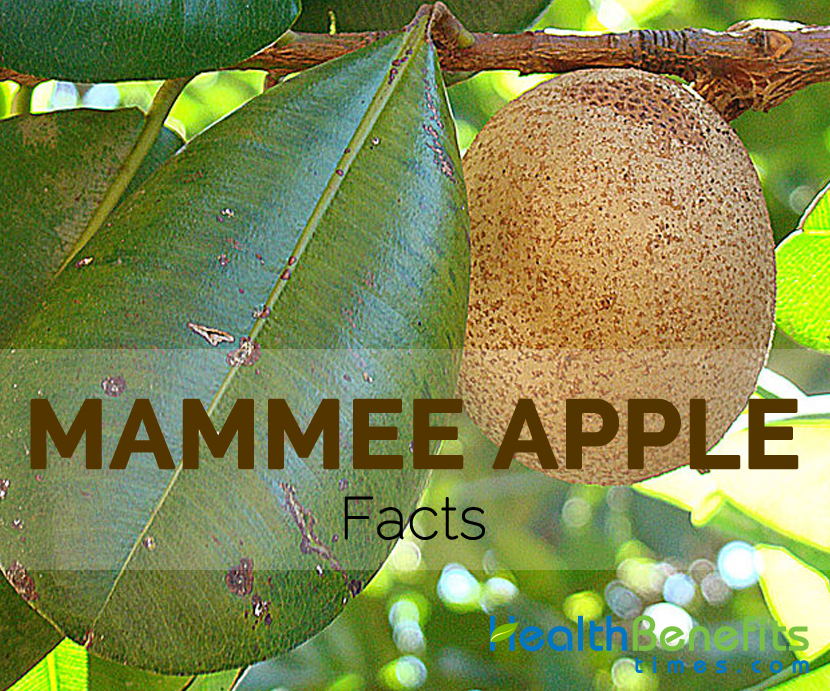 Mammee, also known as mammee apple, mamey and South American apricot, is actually a tropical tree which produces edible fruit.It is actually a berry not a drupe which is 0.5-2 kg which is found used in different types of foods items around the world.
Mammee, also known as mammee apple, mamey and South American apricot, is actually a tropical tree which produces edible fruit.It is actually a berry not a drupe which is 0.5-2 kg which is found used in different types of foods items around the world.
| Name | Mammee Apple |
|---|---|
| Scientific Name | Mammea americana |
| Native | Native of West Indies –Dominican Republic, Haiti, Jamaica, Puerto Rico and the lesser Antilles. |
| Common/English Name | Mamey Tree,Tropical Apricot, Mammee, Mammee Apple,St. Domingo Apricot, Mammey-Apple, Marmalade Tree,Santo Domingo Apricot, South American Apricot, |
| Name in Other Languages | Spanish : Albaricoque De Santo Domingo Albricoque German : Mammi, Mammiapfel Brazil : Abricó-De-São-Domingos, Abricó Danish : Mammeaæble French : Abricot D’ Amerique, Abricot, Abricot De Saint Domingue Portuguese : Abricó, Abrico Do Pará, Abrico Selvagem Eastonian : Ameerika Mammea, Vili: Mammea Czech : Mamej Americká |
| Description | Mammee apple is round or somewhat irregular fruit which have flavor similar to Apricot or red raspberry. It is loaded with many health promoting Nutrients, Vitamins and minerals. |
| Plant Growth Habit | Evergreen, medium-sized tree |
| Growing Climate | Limited to tropical or near tropical moist to wet climates, prefers full sun or light shade |
| Soil | Favors deep, rich, well-drained soil, but is apparently quite adaptable to even shallow, sandy terrain, and it grows naturally in limestone areas too. |
| Plant Size | 18 m– 21 m (59 ft-69 ft.)Tall |
| Stem | Short and reaches 1.9 m- 1.2 m (6 ft 3 in-3 ft 11 in) in diameter |
| Leaf | Leaves are simple, opposite, coriaceous, glabrous, glossy dark-green, broadly elliptic, up to 20 cm long and 10 cm wide. |
| Flowering Season | Starts from May-October |
| Flower | Flowers are fragrant, with 4–6 white petals and orange stamens or pistils, 2.5–4 cm wide when fully open, pistillate or hermaphrodite, staminate, |
| Fruit shape & size | Round or somewhat irregular, with a short, thick stem, 10–20 cm across, greyish brown with a rugose, 3 mm (0.12 in) thick, leathery rind |
| Fruit Weight | 0.5-2 kg |
| Fruit color | Green while young turning to yellow or russet as soon as they Ripe. |
| Flesh Color | Light yellow or orange, not fibrous, the flesh smells pleasant and appetizing. |
| Fruit Peel | Skin is light brown or greyish-brown with small, scattered, scurfy or warty areas, leathery, about 3 mm thick and bitter. |
| Flavor/aroma | Resembling the apricot or red raspberry in flavor. |
| Fruit Taste | Too sour or mawkishly sweet |
| Seed | Fruits contain 1-4 brown, rough, oval and around 6 cm (2.4 in) long seeds. |
| Season | Fruits take up to a year to mature and are ripe from July-February |
| Major Nutrition | Vitamin C 14 mg (15.56%) Carbohydrate 12.5 g (9.62%) Copper 0.086 mg (9.56%) Iron, Fe 0.7 mg (8.75%) Dietary Fiber 3 g (7.89%) Vitamin B6 0.1 mg (7.69%) Magnesium 16 mg (3.81%) Vitamin B9 14 µg (3.50%) Vitamin B2 0.04 mg (3.08%) Vitamin B3 0.4 mg (2.50%) |
| Health Benefits |
|
| Calories in 1cup (100 gm) | 51 |
| Traditional Uses |
|
| How to Eat |
|
| Other Facts |
|

